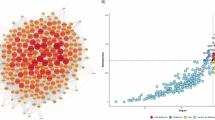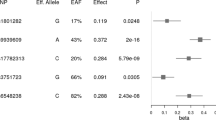Abstract
Background:
The estrogen-related receptor α (ERRα or NR3B1) is a transcription factor from the nuclear receptor super-family, group III. The gene encoding ERRα (ESRRA) is located on chromosome 11q13, a region showing genetic linkage to body mass index and fat percentage. Through interaction with the peroxisome proliferator-activated receptor-γ coactivator-1α (PGC-1α), ERRα regulates key enzymes involved in the β-oxidation of fatty acids.
Results:
By screening 48 overweight or obese subjects for variants in the exons, exon–intron boundaries and 1000 base pairs (bp) of the promoter region of ESRRA using bi-directional nucleotide sequencing, we identified seven variants. Four rare variants had minor allele frequencies (MAF) below 1%: Pro369Pro, Gly406Asp, 3′UTR+418G>A, 3′UTR+505C>A. Two single-nucleotide polymorphisms, Pro116Pro and IVS6+65C>T (MAF 15%), were in complete linkage disequilibrium (LD) (r2=1). We also confirmed the presence of a reported 23 bp microsatellite repeat (ESRRA23). The Pro116Pro and ESRRA23 variants were not associated with obesity, type 2 diabetes or related phenotypes in a large population-based study of 6365 Danish whites. The two variants were examined for interactions with variants in the peroxisome proliferator-activated receptor-γ coactivator-1α and -β; however, no evidence of epistatic effects between the variants was demonstrated.
Conclusion:
The ESRRA23 and Pro116Pro variants of the gene encoding ERRα are not associated with obesity, type 2 diabetes or related quantitative traits in the examined Danish whites.
This is a preview of subscription content, access via your institution
Access options
Subscribe to this journal
Receive 12 print issues and online access
$259.00 per year
only $21.58 per issue
Buy this article
- Purchase on SpringerLink
- Instant access to full article PDF
Prices may be subject to local taxes which are calculated during checkout
Similar content being viewed by others
References
Giguère V, Yang N, Segui P, Evans RM . Identification of a new class of steroid hormone receptors. Nature 1988; 331: 91–94.
Giguere V . To ERR in the estrogen pathway. Trends Endocrinol Metab 2002; 13: 220–225.
Johnston SD, Liu X, Zuo F, Eisenbraun TL, Wiley SR, Kraus RJ et al. Estrogen-related receptor alpha 1 functionally binds as a monomer to extended half-site sequences including ones contained within estrogen-response elements. Mol Endocrinol 1997; 11: 342–352.
Horard B, Vanacker JM . Estrogen receptor-related receptors: orphan receptors desperately seeking a ligand. J Mol Endocrinol 2003; 31: 349–357.
Shi H, Shigeta H, Yang N, Fu K, O’Brian G, Teng CT . Human estrogen receptor-like-1 (ESRL1) gene: genomic organization, chromosomal localization, and promoter characterization. Genomics 1997; 44: 52–60.
Pérusse L, Rankinen T, Zuberi A, Chagnon YC, Weisnagel SJ, Argyropoulos G et al. The human obesity gene map: the 2004 update. Obes Res 2005; 13: 381–490.
Sladek R, Beatty B, Squire J, Copeland NG, Gilbert DJ, Jenkins NA et al. Chromosomal mapping of the human and murine orphan receptors ERR-alpha (ESRRA) and ERR-beta (ESRRB) and identification of a novel human ERR-alpha-related pseudogene. Genomics 1997; 45: 320–326.
Sladek R, Bader JA, Giguere V . The orphan nuclear receptor estrogen-related receptor alpha is a transcriptional regulator of the human medium-chain acyl coenzyme A dehydrogenase gene. Mol Cell Biol 1997; 17: 5400–5409.
Luo J, Sladek R, Carrier J, Bader JA, Richard D, Giguere V . Reduced fat mass in mice lacking orphan nuclear receptor estrogen-related receptor alpha. Mol Cell Biol 2003; 23: 7947–7956.
Huss JM, Kopp RP, Kelly DP . Peroxisome proliferator-activated receptor coactivator-1alpha (PGC-1alpha) coactivates the cardiac-enriched nuclear receptors estrogen-related receptor-alpha and -gamma. Identification of novel leucine-rich interaction motif within PGC-1alpha. J Biol Chem 2002; 277: 40265–40274.
Maehara K, Hida T, Abe Y, Koga A, Ota K, Kutoh E . Functional interference between estrogen-related receptor alpha and peroxisome proliferator-activated receptor alpha/9-cis-retinoic acid receptor alpha heterodimer complex in the nuclear receptor response element-1 of the medium chain acyl-coenzyme A dehydrogenase gene. J Mol Endocrinol 2003; 31: 47–60.
Laganiere J, Tremblay GB, Dufour CR, Giroux S, Rousseau F, Giguere V . A polymorphic autoregulatory hormone response element in the human estrogen-related receptor alpha (ERRalpha) promoter dictates peroxisome proliferator-activated receptor gamma coactivator-1alpha control of ERRalpha expression. J Biol Chem 2004; 279: 18504–18510.
Jorgensen T, Borch-Johnsen K, Thomsen TF, Ibsen H, Glumer C, Pisinger C . A randomized non-pharmacological intervention study for prevention of ischaemic heart disease: baseline results Inter99 (1). Eur J Cardiovasc Prev Rehabil 2003; 10: 377–386.
Alberti KG, Zimmet PZ . Definition, diagnosis and classification of diabetes mellitus and its complications. Part 1: diagnosis and classification of diabetes mellitus provisional report of a WHO consultation. Diabet Med 1998; 15: 539–553.
Andersen G, Wegner L, Jensen DP, Glumer C, Tarnow L, Drivsholm T et al. PGC-1alpha Gly482Ser polymorphism associates with hypertension among Danish whites. Hypertension 2005; 45: 565–570.
Andersen G, Wegner L, Yanagisawa K, Rose CS, Lin J, Glumer C et al. Evidence of an association between genetic variation of the coactivator PGC-1beta and obesity. J Med Genet 2005; 42: 402–407.
Laflamme N, Giroux S, Loredo-Osti JC, Elfassihi L, Dodin S, Blanchet C et al. A frequent regulatory variant of the estrogen-related receptor alpha gene associated with BMD in French-Canadian premenopausal women. J Bone Miner Res 2005; 20: 938–944.
Mueller SO, Korach KS . Estrogen receptors and endocrine diseases: lessons from estrogen receptor knockout mice. Curr Opin Pharmacol 2001; 1: 613–619.
Bonnelye E, Aubin JE . Estrogen receptor-related receptor alpha: a mediator of estrogen response in bone. J Clin Endocrinol Metab 2005; 90: 3115–3121.
Acknowledgements
We are indebted to Annemette Forman, Lene Aabo, Lise Wantzin and Marianne Stendal for dedicated and careful technical assistance and to Grete Lademann for secretarial support. The study is supported by the University of Copenhagen, the Danish Diabetes Association, the Danish Heart Foundation, EEC grant (LSHM-CT-2004-005272) and the Danish Medical Research Council (Grant no. 9902592). The Danish Epidemiology Science Centre is supported by the Danish National Research Foundation.
Author information
Authors and Affiliations
Corresponding author
Rights and permissions
About this article
Cite this article
Larsen, L., Rose, C., Sparsø, T. et al. Genetic analysis of the estrogen-related receptor α and studies of association with obesity and type 2 diabetes. Int J Obes 31, 365–370 (2007). https://doi.org/10.1038/sj.ijo.0803408
Received:
Revised:
Accepted:
Published:
Issue date:
DOI: https://doi.org/10.1038/sj.ijo.0803408
Keywords
This article is cited by
-
A reduced proteomic signature in critically ill Covid-19 patients determined with plasma antibody micro-array and machine learning
Clinical Proteomics (2024)
-
FTO gene polymorphisms and obesity risk: a meta-analysis
BMC Medicine (2011)
-
A comparative genome analysis of gene expression reveals different regulatory mechanisms between mouse and human embryo pre-implantation development
Reproductive Biology and Endocrinology (2010)



